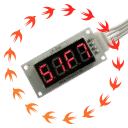https://github.com/SwiftyLinkerKit/SwiftyTM1637
A Swift class to drive the TM1637 chipset (i.e. 7-segment LK-Digi Display)
https://github.com/SwiftyLinkerKit/SwiftyTM1637
swift swiftygpio tm1637
Last synced: 7 months ago
JSON representation
A Swift class to drive the TM1637 chipset (i.e. 7-segment LK-Digi Display)
- Host: GitHub
- URL: https://github.com/SwiftyLinkerKit/SwiftyTM1637
- Owner: SwiftyLinkerKit
- License: apache-2.0
- Created: 2018-06-07T14:03:43.000Z (over 7 years ago)
- Default Branch: develop
- Last Pushed: 2018-06-18T12:30:58.000Z (over 7 years ago)
- Last Synced: 2025-04-03T14:42:24.913Z (8 months ago)
- Topics: swift, swiftygpio, tm1637
- Language: Swift
- Homepage:
- Size: 27.3 KB
- Stars: 5
- Watchers: 1
- Forks: 3
- Open Issues: 0
-
Metadata Files:
- Readme: README.md
- License: LICENSE
Awesome Lists containing this project
- awesome-embedded-swift - SwiftyTM1637 - A Swift class to drive the TM1637 chipset (i.e. 7-segment LK-Digi Display) (Displays / Networking, IoT, Bus Protocols, …)
README
SwiftyTM1637





A
[SwiftyGPIO](https://github.com/uraimo/SwiftyGPIO)
based driver for the TM1637 7-segment chipset,
as used in the
[LK-Digi](http://www.linkerkit.de/index.php?title=LK-Digi)
[LinkerKit](http://www.linkerkit.de)
element.
The module is heavily inspired by the Python code example shown at the
[LK-Digi](http://www.linkerkit.de/index.php?title=LK-Digi)
wiki.
## Example
A simple digital clock:
```swift
import Foundation
import SwiftyGPIO
import SwiftyTM1637
let gpios = SwiftyGPIO.GPIOs(for: .RaspberryPi3)
// E.g. a LK-Digi connected to the P4/P5 digital pins
let display = TM1637(clock: gpios[.P4]!, data: gpios[.P5]!)
display.turnOff()
display.brightness = .typical
while true {
let cal = Calendar.current
let now = cal.dateComponents([.hour, .minute, .second], from: Date())
let hour = now.hour ?? 0
let minute = now.minute ?? 0
let second = now.second ?? 0
let segment2 = SevenSegment(digit: hour % 10, dot: second % 2 != 0)
display.show(s1: hour / 10, s2: segment2,
s3: minute / 10, s4: minute % 10)
Thread.sleep(forTimeInterval: 0.5)
}
```
## How to setup and run
Note: This is for 32-bit, 64-bit doesn't seem to work yet.
### Raspi Docker Setup
You don't have to, but I recommend running things in a
[HypriotOS](https://blog.hypriot.com/post/releasing-HypriotOS-1-8/)
docker container.
Setup is trivial. Grab the [flash](https://github.com/hypriot/flash) tool,
then insert your empty SD card into your Mac
and do:
```shell
$ flash --hostname zpi3 \
https://github.com/hypriot/image-builder-rpi/releases/download/v1.8.0/hypriotos-rpi-v1.8.0.img.zip
```
Boot your Raspi and you should be able to reach it via `zpi3.local`.
I also recommend to use docker-machine (e.g. see
[here](https://github.com/helje5/dockSwiftOnARM/wiki/Remote-Control-Raspi-Docker)),
but that is not necessary either.
### Running an ARM Swift container
Boot the container like so:
```shell
$ docker run --rm \
--cap-add SYS_RAWIO \
--privileged \
--device /dev/mem \
-it --name swiftfun \
helje5/rpi-swift-dev:4.1.0 /bin/bash
```
You end up in a Swift 4.1 environment with some dev tools like emacs
pre-installed. Sudo password for user `swift` is `swift`.
### Creating a small clock
In the container:
```shell
swift@fb630076e0ec:~/testit$ mkdir testit && cd testit && swift package init --type executable
Creating executable package: testit
Creating Package.swift
Creating README.md
Creating .gitignore
Creating Sources/
Creating Sources/testit/main.swift
Creating Tests/
```
Then edit the `Package.swift` file to look like this:
```swift
// swift-tools-version:4.0
import PackageDescription
let package = Package(
name: "testit",
dependencies: [
.package(url: "https://github.com/uraimo/SwiftyGPIO.git",
from: "1.0.0"),
.package(url: "https://github.com/SwiftyLinkerKit/SwiftyTM1637.git",
from: "0.1.2"),
],
targets: [
.target(
name: "testit",
dependencies: [ "SwiftyTM1637", "SwiftyGPIO" ]),
]
)
```
Edit the `Sources/testit/main.swift` and add the Swift code [above](#example).
Build everything:
```shell
swift@fb630076e0ec:~/testit$ swift build
Fetching https://github.com/uraimo/SwiftyGPIO.git
Fetching https://github.com/AlwaysRightInstitute/SwiftyTM1637.git
Cloning https://github.com/uraimo/SwiftyGPIO.git
Resolving https://github.com/uraimo/SwiftyGPIO.git at 1.0.5
Cloning https://github.com/SwiftyLinkerKit/SwiftyTM1637.git
Resolving https://github.com/SwiftyLinkerKit/SwiftyTM1637.git at 0.1.0
Compile Swift Module 'SwiftyGPIO' (10 sources)
Compile Swift Module 'SwiftyTM1637' (4 sources)
Compile Swift Module 'testit' (1 sources)
Linking ./.build/armv7-unknown-linux-gnueabihf/debug/testit
```
You need to run it using `sudo`, password is `swift`:
```shell
swift@fb630076e0ec:~/testit$ sudo .build/armv7-unknown-linux-gnueabihf/debug/testit
```
If your LK-Digi is connected to port D4/D5, it should now show a nice
digital clock!
Want to see it in action?
SwiftyGPIO driven input/output using LinkerKit components
### Who
**SwiftyTM1637** is brought to you by
[AlwaysRightInstitute](http://www.alwaysrightinstitute.com).
We like feedback, GitHub stars,
cool [contract work](http://zeezide.com/en/services/services.html),
presumably any form of praise you can think of.
There is a channel on the [Swift-ARM Slack](http://swift-arm.noze.io).